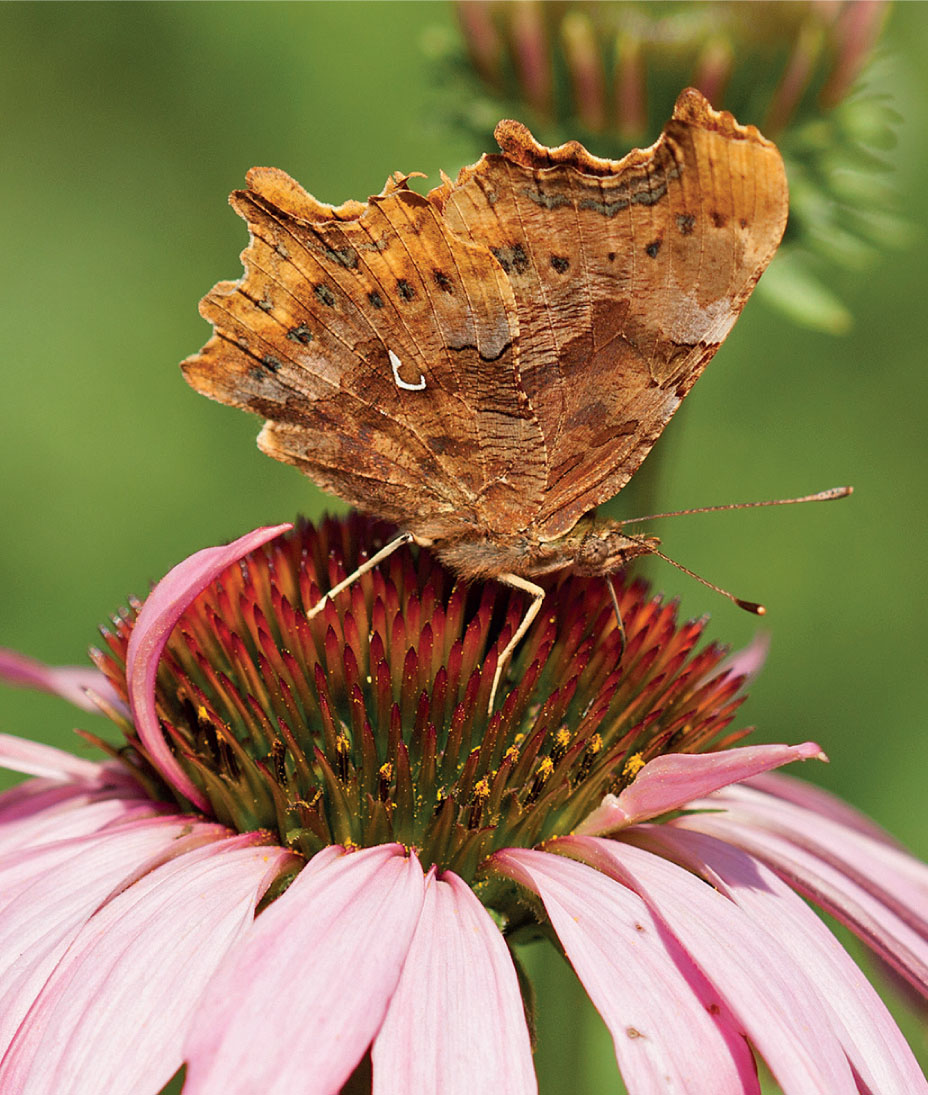
Nectar is the obvious home need for butterflies, but choosing the right flowers is a skill, and delivering all their other needs is an added and exciting challenge.
Gardening for Butterflies
Running the birds a close second in the popularity stakes, butterflies seem to have it all – beautiful colours, a gentle manner and the evocation of lazy, summer days. How could you fail to want more of them in your garden?
As a gardener, you can make plenty of quick and easy gains, boosting both the number of species and the number of individuals that you regularly see in your garden.
Because they are so popular, and because different species require noticeably different things, the following pages look at the 21 commonest garden species in more detail, starting with some of the most glamorous and obvious ones, but it is worth us first taking a quick peek at the most important needs that all butterflies share.
HOME NEEDS
Distribution: About 60 species of butterfly are recorded regularly in the British Isles, but this is just a fraction of the 380 recorded in Europe. I’m afraid the further north you live, the fewer species you will find: some that are as common as muck in southern England are completely absent in Scotland, and several species never made it to Ireland either.
Habitats: Most butterflies are countryside lovers in places where habitats are, by and large, semi-natural. Many are restricted to special habitats such as chalk downland or extensive ancient woodland.
Habits: Some species are migratory, covering huge distances so you will never be able to give them a year-round home. Others live in tight-knit colonies where each individual may only need a few square metres of good habitat, but can only survive if all its friends have their own few square metres too. It means that a colony may need far more space than your garden alone can offer.
Shelter: During the day, butterflies are just as keen sun-worshippers as we are, so they will often congregate in warm sun-traps. The adults also need somewhere to rest overnight or escape from the rain. The caterpillars are also vulnerable, often hiding deep in grass, and when they pupate they are little more than mush trapped in a bite-sized case and so need somewhere undisturbed while they undergo their amazing transformation. And all butterflies must survive the winter in some form, with many hibernating as caterpillars but a few enduring the dark, cold nights as adults.
Caterpillar foodplants: The most important food to provide for butterflies is that for their caterpillars. They are leaf eaters, but are fussy, often only eating those of one particular plant species.
Adult nectar plants: Be aware that butterflies don’t always need nectar – some are much more intent on finding a mate. But those that do like to drink have clear preferences in terms of the flowers they visit, so pick your plants carefully. Many brochures and garden centres highlight plants they claim are good for butterflies, but you can’t always believe the hype. See here for a plant list that is based on proven observation, not wishful thinking. And always remember that butterflies like to have their favourite flowers planted en masse, not just the odd one here and there.
So… Gardening for butterflies involves creating sunny hotspots and filling them – yes, filling them – with the right nectar flowers and the right caterpillar foodplants for the right species.

Nectar is the obvious home need for butterflies, but choosing the right flowers is a skill, and delivering all their other needs is an added and exciting challenge.
Red Admiral
Vanessa atalanta
This is one of our largest, most familiar and striking butterflies, and there’s plenty you can do to give them a helping hand.
HOME NEEDS
Distribution: A strong migrant, reaching most of the British Isles each year from southern Europe, but numbers vary.
Habitat: Found in almost any flower-rich habitat, such as hedgerows, unimproved grasslands, woodland rides, coasts, heaths and riverbanks, with sunny gardens a favourite.
Habits: A bold butterfly, easy to watch, often basking in the sun. The first migrants arrive in spring, with more waves of immigrants following. By autumn, ‘home-grown’ youngsters mix with newcomers, and some attempt to migrate back to the Continent.
Flight season: Those seen in early spring have often overwintered. Migrants arrive from April and can then be seen in any month, usually peaking in autumn, with a few seen as late as December.
Hibernates as: Adult, in rather open locations such as tree trunks, but only a few survive our winters. Some caterpillars are also now surviving in milder parts of the country.
Caterpillar foodplants: Stinging Nettle, especially sunny beds with vigorous growth. May sometimes use Annual Nettle and Pellitory-of-the-wall. The caterpillars fold nettle leaves into a tent where they feed, but they are heavily parasitised by ichneumon flies.
Adult nectar plants: As the year progresses, they come ever more readily to nectar, especially Ivy, Hemp Agrimony (and other Eupatoriums), Verbena bonariensis, Michaelmas daisies, Marjoram, Escallonia bifida and Iceplant. Also uses Red Valerian, Abelia, Devil’s-bit Scabious, Coneflower, Teasel, brambles, thistles and Lysimachia clethroides. They are fond of over-ripe blackberries, apples and plums, will sip at sap and love banana mush!
So… This is one occasion when you might consider gardening for nettles! If not, then a good spread of its preferred nectar flowers and a dollop of mashed banana will work wonders.

To attract Red Admirals in autumn, pummel a ripe banana within its skin until it feels mushy, cut some slits along it, and put it out in a sheltered sunny position – they will stay for hours drinking the juice.
Peacock
Inachis io
Four eyes stare unblinkingly at you from this striking and noisy – yes, noisy – butterfly.
HOME NEEDS
Distribution: Found throughout much of the British Isles except in mountain areas and northern Scotland. It is scarcer in the north but increasing its range.
Habitat: Mainly a butterfly of sunny, flower-rich woodlands and hedgerows, coming frequently into gardens, especially rural ones.
Habits: A wanderer, travelling short distances to find food and nettle-beds. In spring, they feed in the morning and then males take up territory in suitable warm corners to wait for a mate. In autumn, they nectar greedily, somewhere near a spot they have chosen to hibernate. They can ‘hiss’ if startled, flashing their eye-spots to try to scare you.
Flight season: Overwintering adults emerge on warm spring days from March onwards and can still be on the wing in June. The summer brood emerges from July onwards, hibernating from September.
Hibernates as: Adult, in hollow trees and crevices in walls.
Caterpillar foodplants: Stinging Nettle – females lay large egg batches on vigorous plants. The caterpillars spin communal webs but are prone to attack by parasitic wasps. They pupate in trees.
Adult nectar plants: Especially thistles, Inulas and Iceplant. Also Michaelmas daisies, dandelions, Abelia, Osmanthus, Marjoram, Lysimachia clethroides, gayfeathers, Teasel, Verbena bonariensis, Purple Loosestrife, Red Valerian, lavenders, brambles, knapweeds, Coneflower, Hemp Agrimony and spring blossom such as sallows and Blackthorn.
So… Another butterfly for which you’ll need a meaty nettle-bed in a choice position to get them to breed. Providing the adults with plenty of nectar in both spring and autumn may be your preference!

One of the first butterflies of spring, Peacocks often bask on bare ground to soak up the weak sun.
Small Tortoiseshell
Aglais urticae
Once a common butterfly, their populations have nose-dived especially in the south due to a parasite, so give them what help you can.
HOME NEEDS
Distribution: Throughout the British Isles, where it was once abundant but is now much reduced.
Habitat: Wherever there are nettle-beds and flower-rich habitats, so this is a butterfly of farmland, scrub, waste ground and gardens.
Habits: In spring and summer, they wander the countryside, looking for suitable nettle-beds where the males set up territory and watch attentively for females. Some even migrate northwards.
Flight season: Overwintering adults fly during March–May. The first brood then emerges in June–July, and in the south these lead to a second brood in August–October that then hibernates.
Hibernates as: Adult, in sheds and barns. It is too warm in houses, so release them if they get in.
Caterpillar foodplants: Nettles – Stinging and Annual. Females carefully choose fresh growth on large, sunny, sheltered beds for batches of up to 100 eggs. The caterpillars spin a communal web, but can succumb to ichneumon wasp and tachinid fly parasites.
Adult nectar plants: They feed avidly, especially in autumn, on thistles, Michaelmas daisies and Iceplant, but also Ivy, Red Valerian, Coneflower, Water Mint, Marjoram, dandelions, Tansy, Hemp Agrimony, knapweeds, lavenders, brambles, zinnias, Common Ragwort, Inulas, Common Privet, hedge veronicas, Verbena bonariensis, scabiouses, Coltsfoot and blossom such as sallows and Blackthorn.
So… Getting them to breed isn’t easy. You need a large nettle-bed in a sunny position, and you also need to cut it back in midsummer to provide fresh growth. Providing nectar is far easier – fill those flower borders with the suite of beautiful flowers they love.
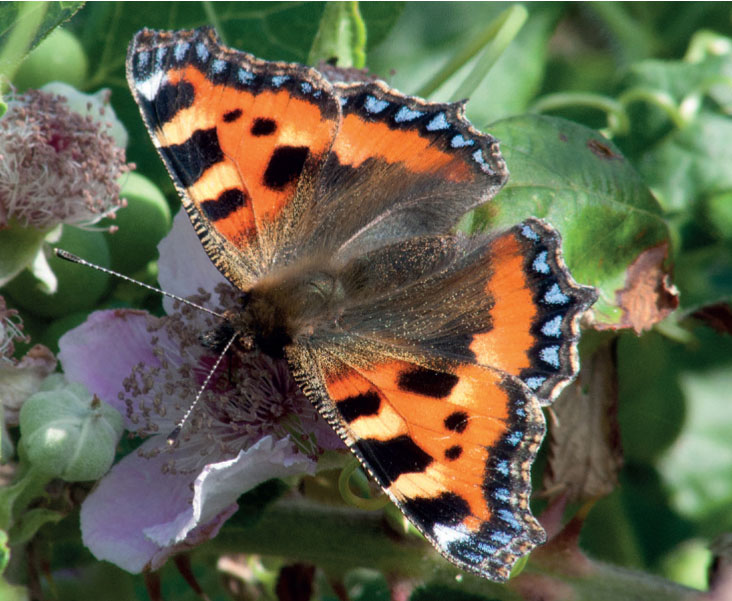
It is a joy to see adults: a parasitic wasp is thought to have played a large part in the species’ decline.
Comma
Polygonia c-album
The loss of so many hopfields where they once bred has dented the fortunes of this golden butterfly with ragged-edged wings, but, encouragingly, it appears to be on the rebound.
HOME NEEDS
Distribution: Southern Britain as far as Yorkshire; not present in Ireland.
Habitat: They like to be near trees, so prefer woodland edges and country lanes, coming regularly to gardens.
Habits: Solitary; they wander around their local ranges without ever straying too far, spending time basking in the sun, up in a tree or even on the ground.
Flight season: They emerge from hibernation in March–April, find a mate, and the females then lay their eggs. The earliest caterpillars of this brood to pupate emerge as a brighter-coloured summer generation in July–August and produce an autumn brood. Late spring caterpillars hatch in August–September.
Hibernates as: Adult, in the dry parts of woods.
Caterpillar foodplants: Hop and Stinging Nettle.
Adult nectar plants: Feeds most avidly in autumn, favourites being Ivy, Michaelmas daisies and Iceplant. Also uses Inulas, Verbena bonariensis, brambles, thistles, lavenders, Coneflower, globe thistles, scabiouses and Hemp Agrimony; in spring, they visit Blackthorn and sallows. Special favourites are over-ripe blackberries and plums, on which they will guzzle until drunk. They also drink sap.
So… Grow Hop plants and let them scramble through hedges and trees. The funky caterpillars usually pupate dangling under the leaves, and so you can watch the life cycle from egg to adult. Back this up with a range of nectar plants and rotting fruit and you should be well rewarded.

Soaking up the sun, the Comma is a splash of deep orange on a spring morning, but when it closes up its jagged-edged wings it looks just like a dead leaf.
Large White
Pieris brassicae
This is one butterfly that can really be a menace in your vegetable garden, but give it nasturtium to distract it and you can learn to love it.
HOME NEEDS
Distribution: Throughout the British Isles.
Habitat: Gardens, allotments, farms and sunny woodland rides. Very common in gardens.
Habits: They wander freely from garden to garden, with resident populations boosted by immigrants from southern Europe. The females are egg machines, laying clumps like massed tiny orange skittles on the underside of cabbage leaves. The black-and-yellow caterpillars feed en masse, turning plants to a skeleton. They taste of mustard, which puts birds right off, but it doesn’t deter parasitic wasps one jot; their larvae grow inside the living caterpillars.
Flight season: The spring generation flies April–June, the second generation from late July–September, and often there is a third generation in autumn.
Hibernates as: Chrysalis.
Caterpillar foodplants: Cultivated brassicas (cabbages, sprouts, kale, broccoli, Oilseed Rape), and also Nasturtium.
Adult nectar plants: They mostly feed in summer and autumn, especially on Verbena bonariensis, Red Valerian and lavenders, plus Marjoram, thistles, scabiouses, knapweeds, Teasel, burdocks, dandelions, brambles, Dame’s Violet, ragworts, Michaelmas daisies and hawkbits.
So… If you have cabbage-growing neighbours, obviously refrain from spawning thousands of Large Whites. But if there’s no-one to upset, grow a sacrificial cabbage or some nasturtium in the flower border and enjoy following the life cycle. If they are a problem in your vegetable patch, monitor your plants and wipe any eggs off the leaves with your fingers for an easy organic solution.
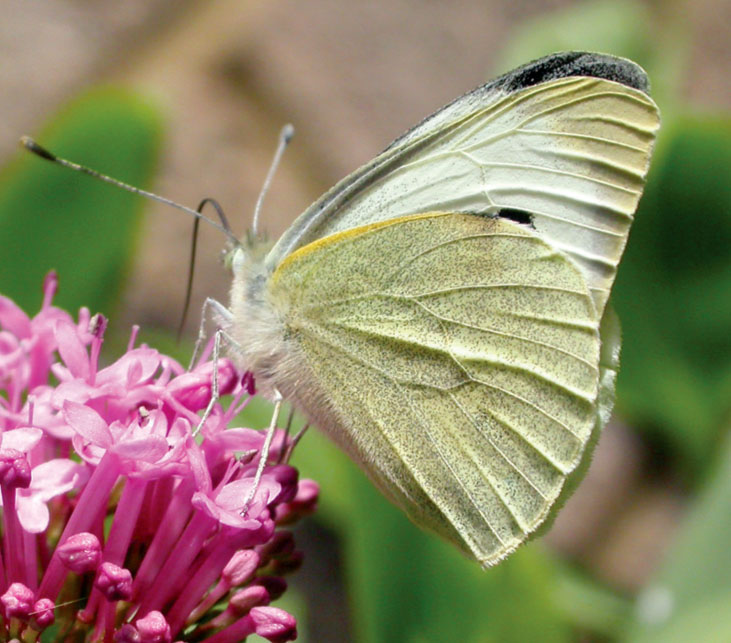
The extensive black tips of the upper forewing (which here show through to the underside like grey-green shadows) separate the Large White from the Small.
Small White
Pieris rapae
The Small White often gets lumped in with its big cousin, the Large, under the title ‘cabbage white’. However, while the Small White’s caterpillar also munches at cabbages, it differs in that it is less destructive, and is edible to birds and beetles.
HOME NEEDS
Distribution: Throughout the British Isles.
Habitat: Gardens, farms, sunny woodlands, especially in nice sheltered spots. Common in gardens.
Habits: Like the Large White, we see a mix of locally bred Small Whites plus migrants from further south. Males and females wander nomadically, and the eggs are laid individually. The green caterpillar doesn’t store up poisons like the Large White but, at first, hides deep in the plant’s heart and later relies on its camouflage. However, they are discovered by many predators including tits, thrushes, harvestmen and beetles.
Flight season: The first brood flies April–June; the second from late July–September. There is often a third brood in autumn.
Hibernates as: Chrysalis.
Caterpillar foodplants: Cultivated brassicas and Nasturtium, and they will use wild brassicas such as Garlic Mustard and Charlock.
Adult nectar plants: As Large White, plus forget-me-nots.
So… Whatever you do to help the Large White will work for the Small. So go on, grow sacrificial cabbages in among your prize dahlias and create quite a talking point!

For a butterfly that looks so similar to the Large White, the Small has quite a different strategy when it comes to laying its eggs.
Painted Lady
Vanessa cardui
A glamorous if unpredictable visitor, all the way – would you believe it – from Africa! If you want proof that nature knows no boundaries, here it is.
HOME NEEDS
Distribution: In a good year, they can seem to be everywhere; in a bad year, few reach us.
Habitat: They like warm, dry, open habitats such as downland, sunny woodlands, dunes, flowery meadows and gardens.
Habits: Painted Ladies never hibernate. Instead, huge numbers hatch in North Africa in the spring and head north across Europe, breeding as they go. However, almost none survive our winters.
Flight season: With a good wind from the Sahara, the first arrive in February, but few usually reach us before May. Subsequent generations can then be seen right through till October.
Hibernates as: It doesn’t!
Caterpillar foodplants: Almost always uses thistles, such as Musk, Spear and Creeping.
Adult nectar plants: Nectars freely, especially from summer onwards, at Verbena bonariensis, Red Valerian, knapweeds, scabiouses, Teasel, Marjoram, Ivy, Iceplant and thistles.
So… It is tempting to grow thistles for the caterpillars, but they are such a pernicious and widespread weed that you are excused if you don’t – hopefully some are growing nearby. Instead, offer loads of good nectar sources for the adults as a good compromise.
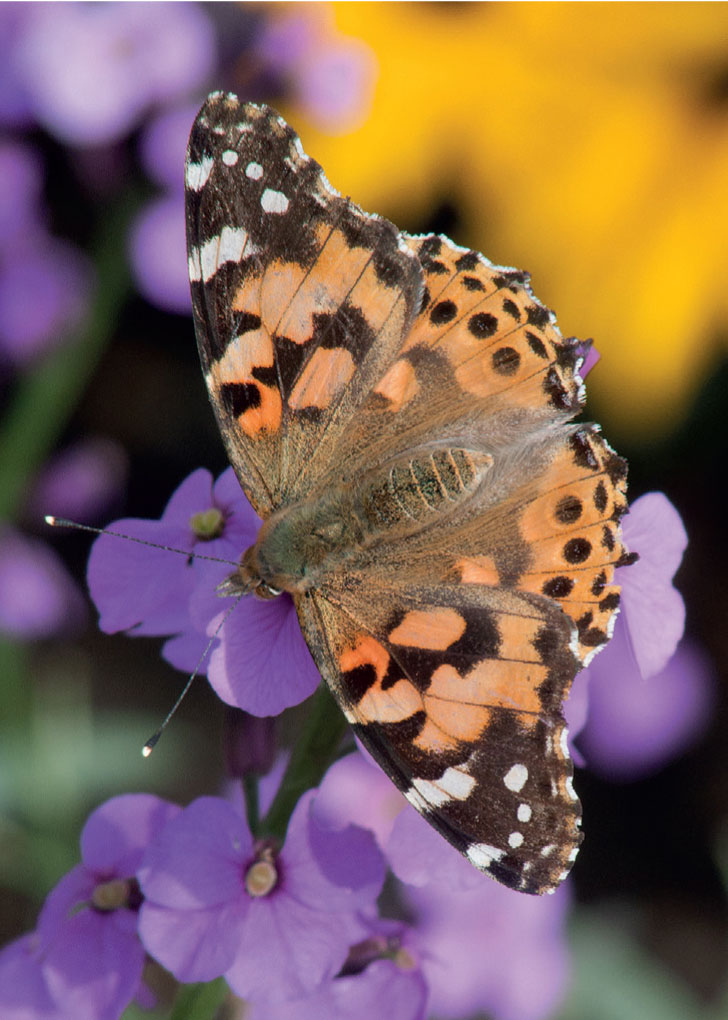
2009 was a bumper year for the Painted Lady, with millions emerging from the Atlas Mountains in early spring, and sweeping north into almost every garden in Britain.
Brimstone
Gonepteryx rhamni
Possibly the ‘butter-coloured fly’ that gave us the word ‘butterfly’, this is a real harbinger of spring in southern areas.
HOME NEEDS
Distribution: Has a distinctly southern and lowland range in Britain, with few found north of Yorkshire or Cumbria. Has a scattered distribution in central Ireland.
Habitat: Sunny woodland glades and rides, hedgerows and country lanes. Fairly common in gardens.
Habits: The males emerge from hibernation on warm spring days and rove nomadically along hedgerows and woodland edges seeking the pale females, who wait coyly in the undergrowth. They have a brief, ecstatic, soaring courtship, after which the female goes seeking buckthorn trees. Adults roost by mid-afternoon.
Flight season: Hibernators emerge March–June. The summer generation flies August–September.
Hibernates as: Adult, often in the evergreen cover of thick Ivy, Holly or brambles.
Caterpillar foodplants: Purging Buckthorn and Alder Buckthorn only. The eggs are laid on young trees in sunny situations.
Adult nectar plants: In spring, they visit woodland flowers such as Bluebell, grape hyacinths, Primrose, Cowslip and sallow blossom. The summer brood feeds more avidly, using Teasel, Purple Loosestrife, thistles, scabiouses, knapweeds, Runner Bean and Betony.
So… If you live in the right area, growing one of the caterpillar’s two foodplants is nigh on compulsory for a wildlife-friendly gardener! Also train Ivy up a tree for hibernation, and grow a range of the right nectar flowers in your border. Look, too, for a wilder, sunny spot where you can grow a flush of Teasel and Marsh Thistle.
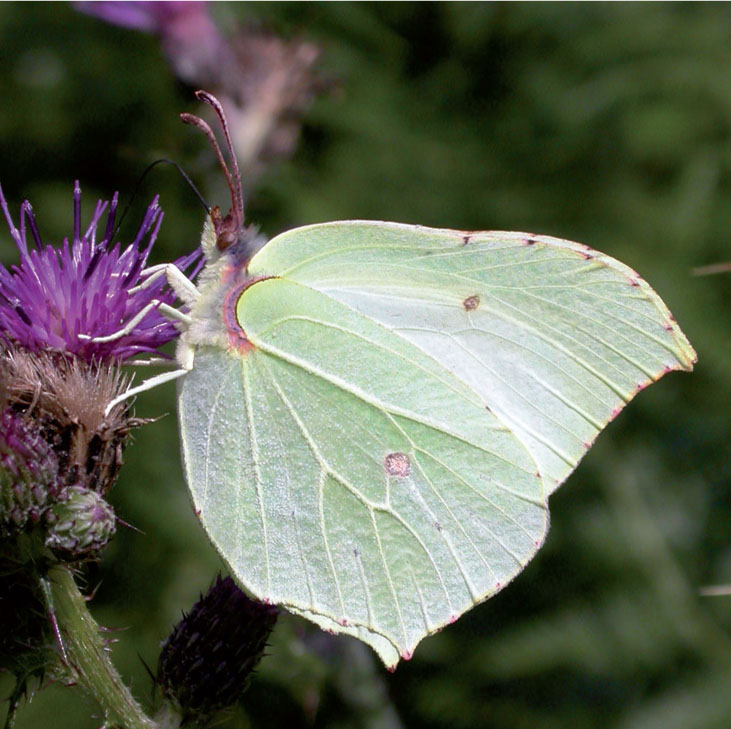
Brimstones only ever settle with their wings closed. This is the female, almost white with a hint of limey-yellow, but even the males don’t reveal their sunshine-yellow upperwings until they fly.
Green-veined White
Pieris napi
Easily dismissed as just another ‘cabbage white’, the Green-veined is a delicate, innocuous butterfly that seeks choice wild weeds rather than your prize cabbages for its caterpillars.
HOME NEEDS
Distribution: Throughout the British Isles except in the highest mountains and Shetland. They are uncommon in urban areas, and rarely abundant anywhere.
Habitat: Damp sheltered hedgerows, ditches and woodland rides. Fairly common in gardens.
Habits: On hatching in spring, the males flutter weakly in search of females. Once mated, the female seeks out tender leaves of the caterpillar foodplants in a trembling, dithering flight, oblivious to your approach. Eggs are laid singly, so there are no infestations of caterpillars as with Large White.
Flight season: The first generation flies April–June, the second July–August. There is sometimes a small autumn emergence, and northern and upland populations may have just one generation in June–July.
Hibernates as: Pupa.
Caterpillar foodplants: The leaves of Garlic Mustard, Lady’s Smock, Hedge Mustard, Charlock and Watercress. Various other crucifers are sometimes used.
Adult nectar plants: Not especially big drinkers, but they will use a range of plants including Garlic Mustard, Lady’s Smock, Dame’s Violet, Honesty, Bugle, Field Scabious, brambles, Verbena bonariensis, Hemp Agrimony and Marjoram. They sometimes sup from muddy puddles for minerals.
So… Growing clumps of the caterpillars’ foodplants in a sheltered, damp part of the garden is almost certain to be successful.
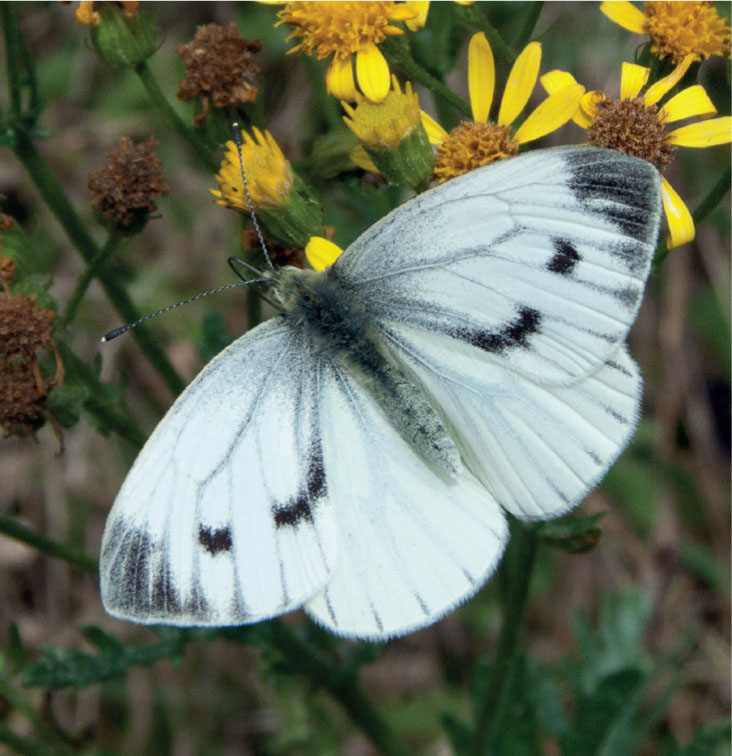
The ‘green veins’ in their name are on the underwings, but even seen from above the veins appear as a delicate grey tracery and are characteristic.
Orange-tip
Anthocharis cardamines
A beautiful butterfly, the first male indicates that spring is here, the last signals that spring is over.
HOME NEEDS
Distribution: Throughout much of the British Isles, but scarce in the north, and absent from most upland areas. Uncommon in towns.
Habitat: Country lanes, open woodlands and edges, ditches and wet meadows. Fairly common in rural gardens.
Habits: The males hatch on warm days in April and May and wander for miles along hedges and ditches in search of shy females. They form more cohesive loose colonies in the north. Once mated, the females quickly seek out large, vigorous foodplants to lay their eggs, one per plant. The caterpillars eat the flowers and developing seedpods.
Flight season: April–June.
Hibernates as: Pupa.
Caterpillar foodplants: Garlic Mustard and Lady’s Smock.
Adult nectar plants: Lady’s Smock and Garlic Mustard, plus can also be found at a range of mainly woodland flowers such as Bugle, Pignut, forget-me-nots, Wild Strawberry, Primrose and Bluebell.
So… It is all down to that duo of caterpillar foodplants: if you don’t have either growing lushly in damp, sheltered places, any visits the adults make will be flying ones!

The female Orange-tip (top) lacks the bright wing markings of the male (below), making her even less conspicuous to add to her already secretive nature.
Holly Blue
Celastrina argiolus
You can easily help this radiant and high-flying beauty breed in southern gardens, even in city centres.
HOME NEEDS
Distribution: Throughout England and Wales as far north as the Lake District. In Ireland, mainly in the east and south.
Habitat: Shrubs, woodland edges and gardens in sunny sheltered locations.
Habits: Flits alone over the tops of bushes, wandering from garden to garden and easily vaulting the tallest of hedges and fences. Alights on sunny leaves. Rarely comes down to ground level except to sip minerals from muddy puddles. Populations fluctuate wildly due to the caterpillars being attacked by a type of small parasitic wasp.
Flight season: Two generations: April–June and July–August. In warm years, there can be a small third generation in October in the south. Sometimes in the north there is just one extended generation.
Hibernates as: Pupa.
Caterpillar foodplants: The spring generation usually lays eggs on Holly, where the caterpillar feeds on flower buds, leaves and old berries. Second generation eggs are laid mainly on Ivy, the caterpillar feeding on the young berries, but also on Dogwood, Spindle, gorses and Snowberry.
Adult nectar plants: They only occasionally visit flowers, such as Hemp Agrimony, Mexican Orange Blossom and Green Alkanet, spending far more time drinking honeydew from the tops of trees.
So… For almost guaranteed success within their range, grow female Holly bushes in a sunny place, with a male bush nearby to ensure berries are formed, and allow Ivy to scramble into a sunny position where it can flower and fruit.
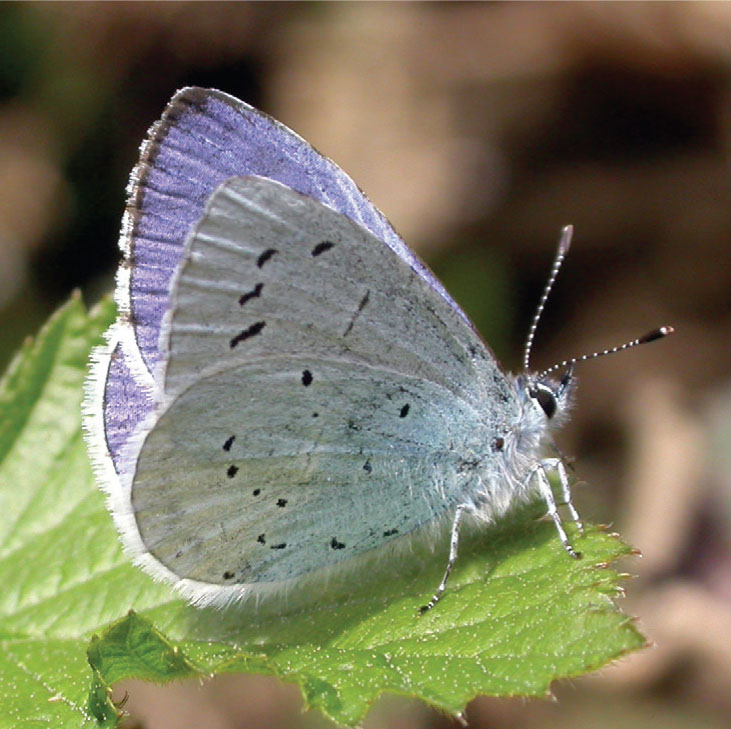
A rare glimpse of the upperside of the Holly Blue. It usually settles with its wings closed revealing the distinctive silvery ground colour underneath, flecked black. This is a male – the female has thick black tips to the upper forewing.
Common Blue
Polyommatus icarus
A stunning jewel of a butterfly. Although it is the commonest blue in the countryside, it is quite difficult to cater for in gardens but well worth the effort.
HOME NEEDS
Distribution: Scattered throughout most of the British Isles, but scarcer in the north. However, much of the countryside is now unsuitable for it.
Habitat: ‘Unimproved’ grassy places in the lowlands, such as downland, old pasture, verges, quarries, dunes, open woodlands and clifftops, with areas of long and short grass. Uncommon in gardens.
Habits: They live in colonies spread over half a hectare or more, with only a few individuals wandering beyond its boundaries, and rarely fly higher than knee height. Males defend their own personal patch from atop grasses and flowers, waiting for rivals or females to pass. At night, colonies often roost communally, heads downwards on grass stems.
Flight season: In the south, the first generation flies mid-May–mid-June, the second late July–September, with sometimes a small third generation in October. In the north, there is often only one generation, flying during June–August.
Hibernates as: Caterpillar.
Caterpillar foodplants: Mainly Common Bird’s-foot Trefoil leaves. Also uses Black Medick, Lesser Trefoil, Common Restharrow and Greater Bird’s-foot Trefoil. Eggs are laid on young fresh growth.
Adult nectar plants: Common Ragwort, Marjoram, Common Bird’s-foot Trefoil, knapweeds and Devil’s-bit Scabious.
So… The key is to have enough flower-rich grassland full of Bird’s-foot Trefoil to support a colony. So you either need a garden large enough, or for your mini-meadow to augment meadows and verges nearby, in which case why not get cooperative with your neighbours?
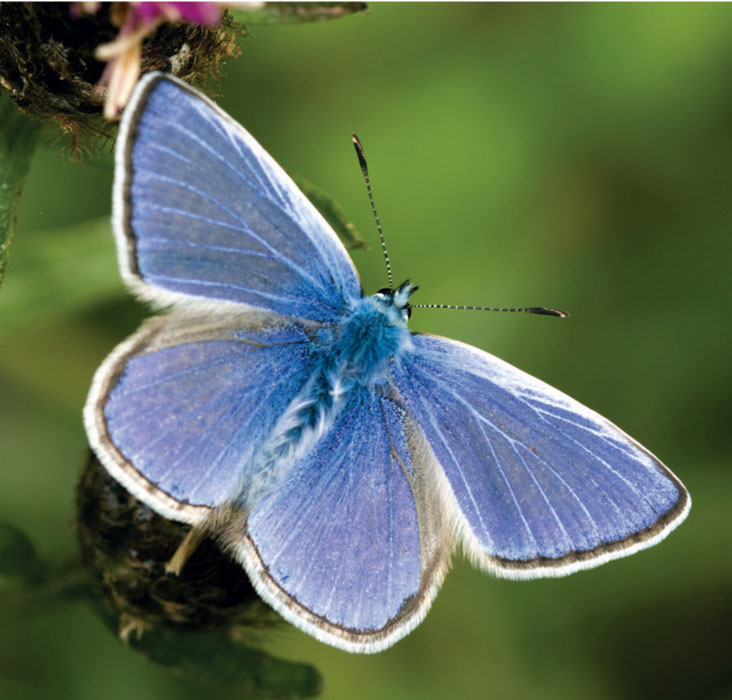
A dazzling male. Female Common Blues are brown above, with usually just a hint of blue where the wings meet the body.
Speckled Wood
Pararge aegeria
The wings look as if dappled with weak sunlight, perfect for this shade-loving butterfly.
HOME NEEDS
Distribution: Common over much of southern Britain and throughout Ireland, but absent from most upland areas and in Scotland except for a patchy distribution in the west and the Great Glen.
Habitat: Deciduous woodlands, preferring a fairly closed canopy where shafts of sunlight spotlight the woodland floor and small areas of woodland grasses grow. Fairly common in gardens.
Habits: They live in loose colonies where males guard a sunbeamed territory, either taking up static sentry duty or patrolling up and down, waiting for a female to venture out. All spend lots of time up in the canopy.
Flight season: The first generation flies April–June, with those that overwintered as pupae emerging first. There is a second generation in late summer and often a third in autumn, with such extended emergence periods that adults can be seen on the wing in almost every week from April to October.
Hibernates as: Caterpillar or pupa.
Caterpillar foodplants: Generally coarse wild grasses such as Cocksfoot, False Brome and Yorkshire Fog.
Adult nectar plants: Occasionally comes to brambles, dandelions and Hemp Agrimony, ripe blackberries and windfall fruit, but happiest at honeydew.
So… Do you have big, deciduous trees where you can create the feel of a patch of woodland and grow native coarse grasses sparsely underneath? It doesn’t really matter which trees – in my garden, they’re very happy with honeydew-rich Sycamores.

A typical posture for a Speckled Wood, wings open in a sunny sheltered position among the leaves of a tree, looking as dappled as the light around it.
Gatekeeper
Pyronia tithonus
Resplendent in chocolate and gold, this familiar face of high summer along southern country lanes has a bit of a weakness for Marjoram.
HOME NEEDS
Distribution: In a sharp divide, they are common (but declining) south of the Pennines but absent from most of northern England and all of Scotland. In Ireland they are only found in the south.
Habitat: Grassy places with bushes, especially hedgerows, woodland rides and scrubby downland, and where the grasses grow tall. Fairly frequent in gardens, but scarce in urban areas.
Habits: Males flutter slowly along hedgerows within their loose colony looking for females, rarely leaving the cosy shelter of sunny shrubs. In a good year, there can be hundreds in choice habitats. Males and females often sit soaking up the sun and taking nectar, while in woodland they fly to treetops for honeydew.
Flight season: Mid-July–August.
Hibernates as: Caterpillar.
Caterpillar foodplants: A range of wild grasses including bents and fescues, ie not what most people have in their lawn. They especially like tall patches of grass growing in the sunny lee of bushes.
Adult nectar plants: They adore Marjoram, but are also partial to Common Ragwort, Common Fleabane and brambles. They will use scabiouses, knapweeds, lavenders, sea hollies and thistles. The only have short probosces, so can’t feed from tubular flowers.
So… If Gatekeepers breed in suitable habitat nearby, then a few are likely to potter through your garden each year, and a Marjoram plant or two will be much appreciated. If you have space for a mixed hedge next to a meadow area, there is every chance they will adopt the garden as part of their colony’s home.

This female Gatekeeper is feeding on the much-favoured Common Fleabane. Similar to the Meadow Brown, note the telltale orange patch on the rear upperwing.
Meadow Brown
Maniola jurtina
It may be the commonest butterfly of meadows – in fact probably the commonest butterfly full stop – but changes in the countryside mean that numbers are not what they used to be.
HOME NEEDS
Distribution: Widespread and abundant resident throughout the British Isles except the highest mountains and the far north.
Habitat: Warm grasslands where wild grasses grow fairly tall interspersed with wildflowers, such as in hay meadows, verges, woodland rides and hedgerows. They regularly wander into gardens, although rarely get a chance to breed there.
Habits: They live in large colonies, the males bobbing through the grasses looking for females, even in dull weather.
Flight season: One long season June–October.
Hibernates as: Caterpillar, deep in the grass.
Caterpillar foodplants: Medium and fine-leaved wild grasses such as bents, fescues, False Brome, meadow-grasses and ryegrasses.
Adult nectar plants: They are especially fond of knapweeds, scabiouses, Creeping Thistle and brambles, also coming regularly to ragworts, Red Valerian, Tansy, Common Fleabane, lavenders and Marjoram, and sometimes at Coneflower and Hemp Agrimony.
So… Yes, you can grow flowers in your borders that will waylay an individual or two wandering from their colony, but creating a wildflower meadow is the big goal and could mean that you entertain dozens and their offspring.

They might be one of our dullest-coloured butterflies, but if a colony forms in your garden it is a sign that you are well on track to creating a healthy meadow habitat. This is a female; males lack the orange patch on the upper forewing.
Ringlet
Aphantopus hyperantus
This dark-chocolate butterfly is easily mistaken for the Meadow Brown, until you bend down and spot the exquisite chain of eye-spots all the way down its underwing.
HOME NEEDS
Distribution: Found throughout much of the British Isles, although absent from north-western England and northern Scotland. Infrequent in urban areas.
Habitat: Moist tall grasslands, often with some shade as in woodland rides or along hedge-side ditches, and especially on clay soils. Uncommon in gardens.
Habits: A colonial species, males bob weakly through tall grasses in search of females, even in cloudy weather, often pausing to rest on grass stems and leaves. The females drop their eggs seemingly randomly into tall grasses while in flight!
Flight season: Late June–early August.
Hibernates as: Caterpillar.
Caterpillar foodplants: Coarse wild grasses such as Cocksfoot, False Brome, Common Couch and Tufted Hair-grass.
Adult nectar plants: Not the most eager of feeders, but uses brambles, thistles, Saw-wort, Hemp Agrimony, and will sometimes come to Inulas, Tansy, Coneflower, ragworts, scabiouses, Wild Privet, knapweeds and sea hollies.
So… A few clumps of the Ringlet’s preferred grasses won’t satisfy a colony, and you will need to be within spitting distance of an existing population for a few individuals to stray into your garden and set up home. But if you are in a suitable damp location and have the space, then let wild grasses grow tall along hedgerows and around bushes.

Ringlets take the idea of adorning yourself with false eyes to the extreme. It is designed to startle predators, or make them peck at the wing rather than the vulnerable real eyes.
Wall Brown
Lasiommata megera
This is a sun-worshipper extraordinaire, seeking out the best-baked spots to raise its body temperature. You’d think it would be doing well with climate change, but its range has shrunk dramatically, so help is welcome.
HOME NEEDS
Distribution: A scattered resident throughout much of lowland England, Wales and Ireland, but now much declined and absent from many inland areas in the south. In Scotland it is only found in a few southern coastal areas.
Habitat: Unimproved grassy areas where the vegetation is short, the terrain bumpy, and there is exposed bare ground and rocks, such as coastal cliffs, grassy heaths, wasteground and downland. Fairly regular in sunny gardens in core parts of their range. Males perch, wings open, on sunny tracks, stones and, of course, walls. If disturbed, they fly strongly for 20 metres or so, before dropping back down. Females lay their eggs where the turf is broken.
Habits: They live in loose colonies of just a few dozen individuals.
Flight season: Two generations, May–June and July–September, with an occasional third brood in warm years in October.
Hibernates as: Caterpillar in the grass.
Caterpillar foodplants: Wild grasses such as False Brome, Cocksfoot, Tor-grass, Yorkshire Fog and Wavy Hair-grass.
Adult nectar plants: Not a huge drinker, but they will come to knapweeds and scabiouses, and sometimes to ragworts, hawkbits, Common Fleabane, Red Valerian, lavenders and Verbena bonariensis.
So… This is yet another grassland species where a typical ryegrass lawn is not what the butterfly is looking for. Instead, give them a sparse wild meadow in as sunny a microclimate as possible, with bare, sun-baked areas.
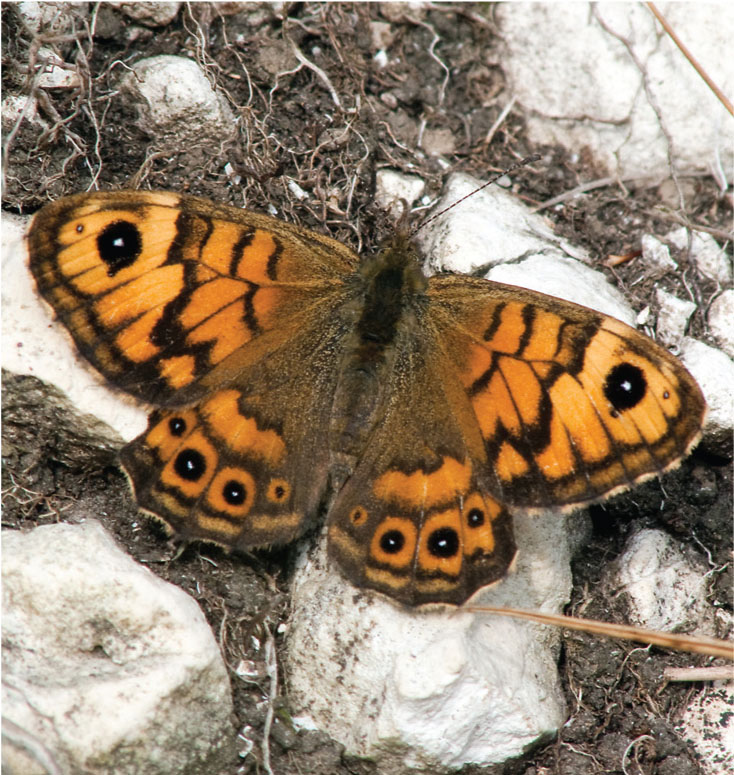
The Wall Brown is rather like a Speckled Wood with the pale areas coloured orange, but the habitats they live in are quite different. Here one is enjoying its preferred sunbed of bare rocks.
Small Copper
Lycaena phlaeas
This is a bright, bold and energetic little gem, but another of those species whose caterpillars have very picky tastes and whose numbers are much declined.
HOME NEEDS
Distribution: Throughout much of the British Isles, though scarcer in the north and upland areas.
Habitat: Warm, dry places such as heaths, downland, road verges, dunes and quarries, preferring areas with quite sparse vegetation. Uncommon in gardens.
Habits: The male is a little bundle of brightness, buzzing around his small territory, which is often within a larger area used by a dozen or so adults. He waits on a prominent stem or grasshead and then launches himself to intercept any insect that passes, seeing them off in a quick aerial dog-fight, unless it is a female willing to be wooed!
Flight season: The spring generation flies May–June, followed by a summer generation in August, and in the south a third generation September–October.
Hibernates as: Caterpillar.
Caterpillar foodplants: Common and Sheep’s Sorrel.
Adult nectar plants: Especially likes Common Ragwort and forget-me-not species, but will also come to Marjoram, Devil’s-bit Scabious, Tansy, thistles, goldenrods, Michaelmas daisies, Yarrow, Verbena bonariensis, heathers, Common Fleabane and Iceplant.
So… They occasionally stray into gardens, but you are most likely to succeed if you can turn your lawn into a sunny, sorrel-rich meadow for a whole colony.
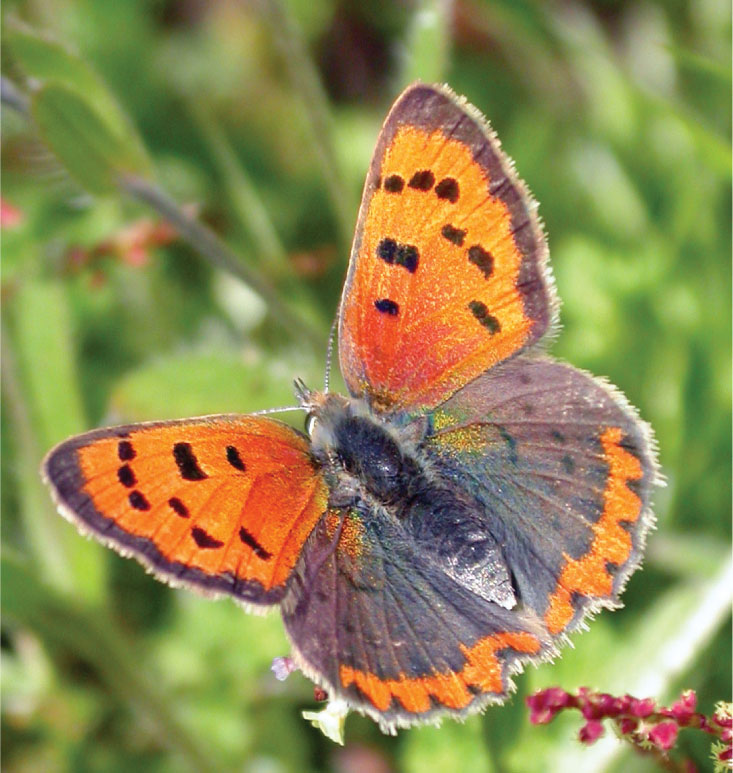
Look carefully and you will see that this Small Copper is resting on one of its food plants – Sheep’s Sorrel, with its inconspicuous tiny red flowers.
Small/Essex Skipper
Thymelicus sylvestris/lineola
Here are two almost-identical butterflies with almost-identical home needs. You will need to get on your hands and knees to tell these little fellas apart!
HOME NEEDS
Distribution: The Small is found throughout England and Wales as far north as Northumberland; the Essex’s range is south-eastern, only reaching as far north as the Midlands. Both are extending their ranges northwards.
Habitat: Unimproved, sunny grasslands where the grasses grow tall, such as meadows and road verges. They are uncommon in gardens.
Habits: Both live in colonies that can cover an extensive or relatively small area (but usually still larger than most gardens!). Males set up little territories, often on the lookout from the top of a grass stem, flying out speedily at knee-level to check passing insects. Females wander between the grass stems laying eggs, resting or nectaring.
Flight season: Late June–August for Small; July–August for Essex.
Hibernates as: Caterpillar for Small; egg for Essex.
Caterpillar foodplants: Wild grasses: Yorkshire Fog for the Small, Cocksfoot or Creeping Soft-grass for the Essex, with both sometimes using several other wild grasses.
Adult nectar plants: Not especially big drinkers, but they feed at a wide range of flowers including knapweeds, hawkbits, Iceplant, Marjoram, Common Ragwort, vetches, thistles, scabiouses, Ox-eye Daisy, clovers, brambles, catmints, lavenders and Teasel.
So… The creation of a fairly large mini-meadow full of wild grasses is your real goal here, although you will probably need to be close to an existing colony to be successful.

The key to telling Small Skippers from Essex is the tip of their antennae – in the Small they are orangey underneath; in the Essex they look as if they have been dipped in black ink. This is the Small – it’s ludicrously difficult, isn’t it!
Large Skipper
Ochlodes venata
A golden whirlwind of early summer that, like the other skippers, holds its tiny wings in a curious ‘pop-up book’ fashion.
HOME NEEDS
Distribution: Widespread across England and Wales, and just over into the Scottish Borders, where its range is expanding.
Habitat: Anywhere where its preferred grasses grow tall and undisturbed in the sunny lee of shrubs, so is widespread along hedgerows, woodland rides, verges and unimproved grasslands. Uncommon in gardens.
Habits: Lives in small colonies. Males perch on conspicuous vantage points, such as sunny leaves, to wait for a female to come by, zooming out to intercept any butterfly that passes. At times, often in the morning, they will also patrol actively seeking mates. The females carefully lay eggs on grass leaves. Both males and females will bask in the sun and take nectar.
Flight season: Late May–August.
Hibernates as: Caterpillar.
Caterpillar foodplants: Coarse wild grasses, in particular Cocks-foot, but they will eat False Brome, Tor-grass and Purple Moor-grass.
Adult nectar plants: They are big fans of brambles, and also regularly visit Marsh and Creeping Thistles and the knapweeds, plus geraniums, buttercups, vetches (eg Tufted Vetch, Meadow Vetchling), clovers, hawkbits and lavenders.
So… You either need enough space for a whole colony – maybe half a hectare – or for your garden to augment an existing colony. Let native grasses grow tall on the sunny side of bushes, with a bit of bramble scrambling through to make them extra happy.
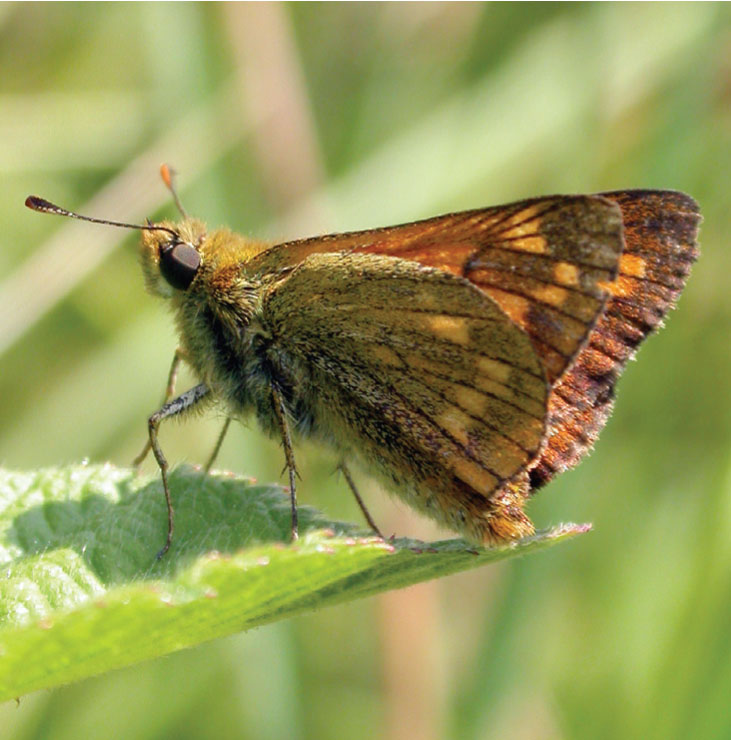
A little bit easier to identify than Small and Essex, the pale ‘windows’ in the wings of the Large Skipper show up well here with the light shining through.
Rarities
Just as with birds, it is always possible that your garden might one day entertain a butterfly that is out of the ordinary. Your best chance is if you live near to one of the ‘special’ butterfly habitats, places where the really picky species live. Such butterflies might be rather attractive guests to hope for, but they are ever so difficult to please!
The most amazing butterfly habitat we have is chalk and limestone downland. There is something about the richness of the plant life and the warm, sunny slopes that keeps a whole range of rare species happy. If you live on or very near downland and can recreate some of these conditions, you stand a good chance of seeing species such as Chalkhill Blue Polyommatus coridon, Adonis Blue P. bellargus, Brown Argus Aricia agestis and Dark Green Fritillary Argynnis aglaja.
Another fantastic habitat is ancient coppiced woodland. If you live in the south with such a haven nearby, a White Admiral Limenitis camilla might come soaring and swooping around your garden like a caped superhero, along with its sidekick, the golden Silver-washed Fritillary Argynnis paphia.
If you have mature oak trees in your garden, it is quite possible that you are host to a colony of Purple Hairstreaks Neozephyrus quercus. If your tree-climbing days are over, then spotting them skipping around the canopy will require some high-summer neck-craning, or you could try to tempt them down to ground level with some choice bramble flowers.
Another species that can match the Painted Lady as a great explorer is the Clouded Yellow Colias croceus. It travels to us all the way from the Mediterranean and North Africa, sometimes by the thousand, although good years come by seemingly randomly and are peppered by several years of dearth. 1877 – now that was a year to remember, although 1996 is perhaps fresher in our memories!
Another good bet for a visit to some gardens is that flying chequerboard, the Marbled White Melanargia galathea. It lives in southern unimproved meadows and downs, but the odd one or two are prone to undertaking a bit of garden exploration. The Small Heath Coenonympha pamphilus, with its endearing habit of leaning right over to hide its shadow, is not quite such a strong flyer but may also make it from dry meadows into some gardens.
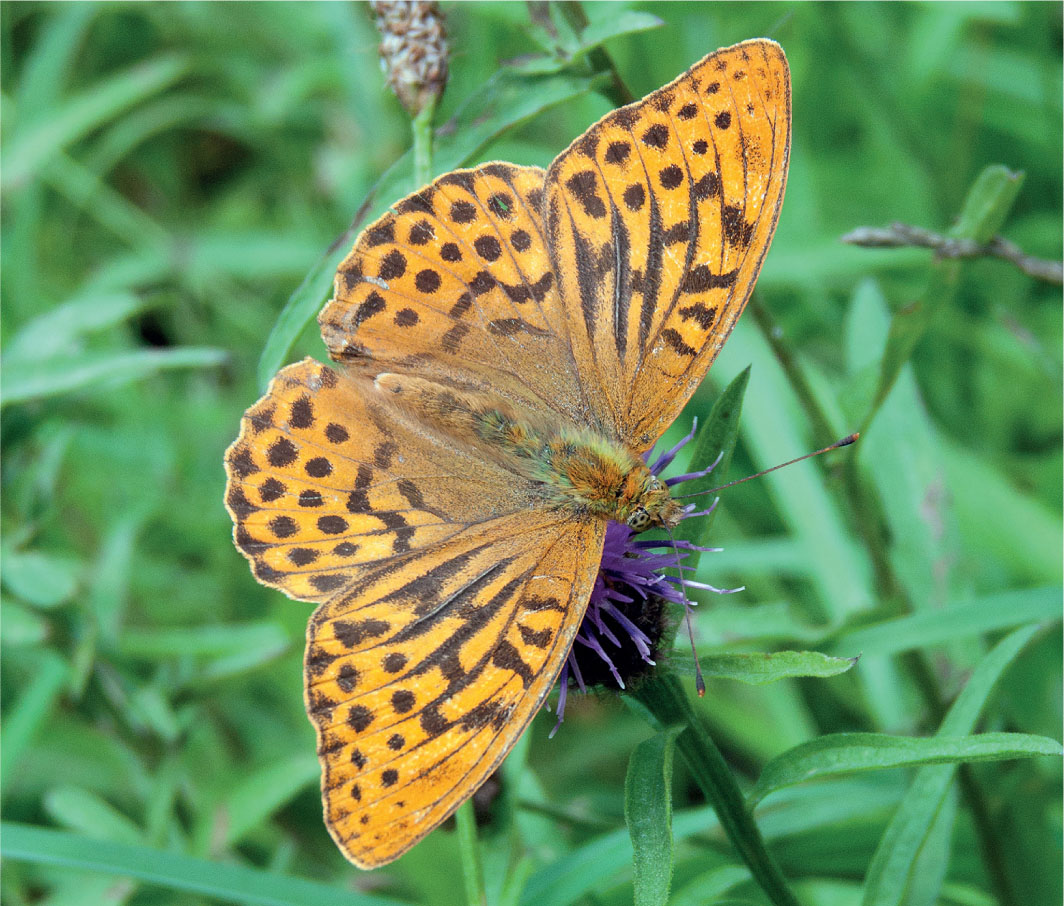
If you live near to woodland in southern Britain, there is every chance that a spectacular Silver-washed Fritillary may come wafting into your garden, and will even pause if you have butterfly-friendly flowers – a moment to treasure.

The Chalkhill Blue does what it says on the tin – it is a blue that lives on chalky (or limestone) hills, such as the North and South Downs, Chilterns and Cotswolds.
Top 20 flowers for butterflies
Here is my pick of the best garden flowers for butterflies, with the species that are likely to use them. Remember to grow them en masse and in a sheltered, warm and sunny location for an even better chance of success.
Marjoram Origanum vulgare – Gatekeeper (left), Meadow Brown, Common Blue, skippers, Red Admiral, Painted Lady, Small Tortoiseshell, Small Copper.

Ivy Hedera helix – Red Admiral, Comma, Painted Lady (left).

Verbena bonariensis – whites, Red Admiral, Painted Lady, Small Tortoiseshell, Peacock, Small Copper, Small White (left).
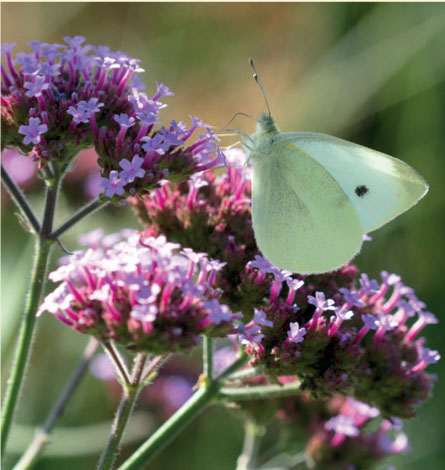
Buddleja x weyeriana – Red Admiral, Small Tortoiseshell, Painted Lady, Small Copper (left), Peacock, Comma, Brimstone, whites. (Buddleja davidii is now not recommended.)

Black Knapweed Centaurea nigra – Gatekeeper, Green-veined White (left), Meadow Brown, Common Blue, Brimstone, Small Tortoiseshell, skippers, Painted Lady, Peacock, whites.
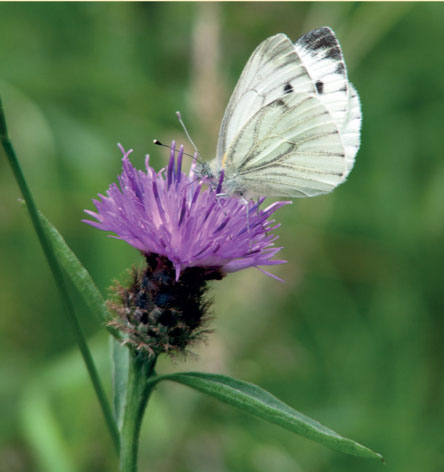
Bramble Rubus fruticosus – Red Admiral (left), Small Tortoiseshell, Peacock, Comma, Speckled Wood, Gatekeeper, Meadow Brown, Ringlet, skippers.

Field Scabious Knautia arvensis – Red Admiral, Painted Lady, Small Tortoiseshell, Meadow Brown (left), Brimstone, skippers, whites.

Devil’s-bit Scabious Succisa pratensis – Red Admiral, Painted Lady, Small Tortoiseshell, Meadow Brown (left), Common Blue, Small Copper, whites.

Hemp Agrimony Eupatorium cannabinum – Red Admiral, Small Tortoiseshell, Peacock, Speckled Wood, Meadow Brown, Ringlet, Holly Blue, whites.

Michaelmas Daisy Aster novi-belgii (singles only) – Red Admiral (left), Small Tortoiseshell, Peacock, Small Copper, whites.

English Lavender Lavandula angustifolia – Small Tortoiseshell (left), Peacock, Meadow Brown, whites.
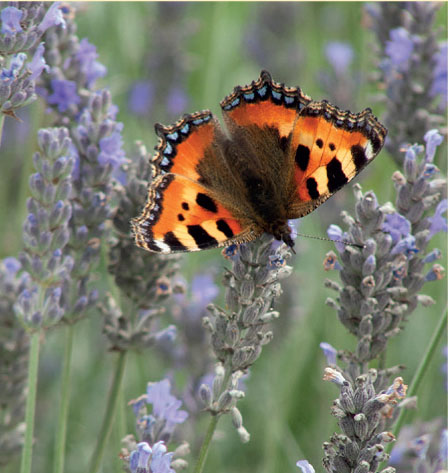
Marsh Thistle Cirsium palustre – Gatekeeper, Meadow Brown, Brimstone (left), whites, skippers, Small Copper, Red Admiral, Painted Lady, Small Tortoiseshell, Peacock, Ringlet.

Iceplant Sedum spectabile – Red Admiral, Small Tortoiseshell, Peacock, Painted Lady, Comma, Small Copper.
Blackthorn Prunus spinosa – Comma, Small Tortoiseshell, Peacock.
Red Valerian Centranthus ruber – Red Admiral, Small Tortoiseshell, Peacock, Meadow Brown, whites.
Tickseed Coreopsis verticillata – whites, Gatekeeper, Small Skipper.
Goat Willow (Sallow) Salix caprea – Peacock, Small Tortoiseshell, Comma, Brimstone.
Common Fleabane Pulicaria dysenterica – Gatekeeper, Meadow Brown, Brimstone, Common Blue.
Lady’s Smock Cardamine pratensis – Orange-tip, Green-veined White.
Coneflower Echinacea purpurea – Red Admiral, Small Tortoiseshell, Peacock, Meadow Brown.
Top 10 plants for butterfly caterpillars
Actually you’ve got a bargain – I’ve given you ten and a whole host of grasses too.
Stinging Nettle Urtica dioica – Red Admiral, Small Tortoiseshell, Peacock, Comma.
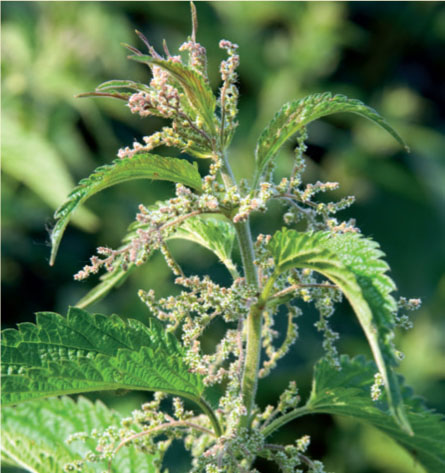
Hop Humulus lupulus – Comma.
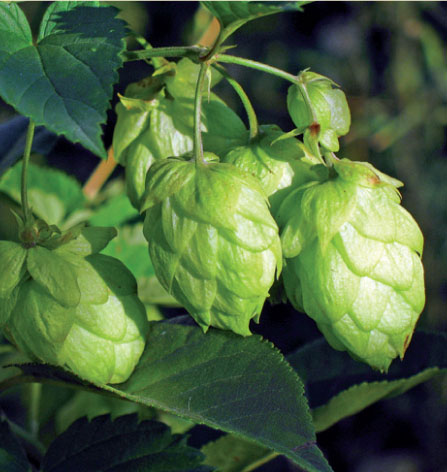
Garlic Mustard Alliaria petiolata – Green-veined White, Orange-tip.

Lady’s Smock Cardamine pratensis – Green-veined White, Orange-tip.
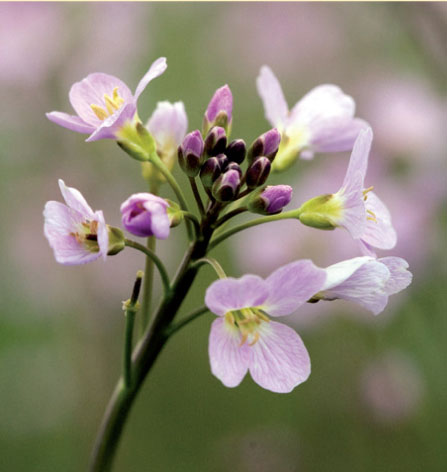
Purging Buckthorn Rhamnus cathartica and Alder Buckthorn Frangula alnus (illustrated) – Brimstone. Note the caterpillar on the midrib.

Holly Ilex aquifolium (illustrated) and Ivy Hedera helix – Holly Blue.
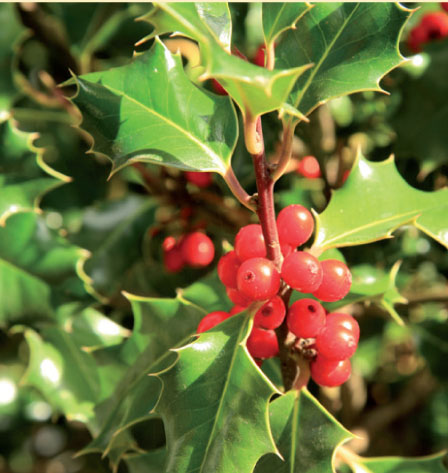
Common Bird’s-foot Trefoil Lotus corniculatus – Common Blue.
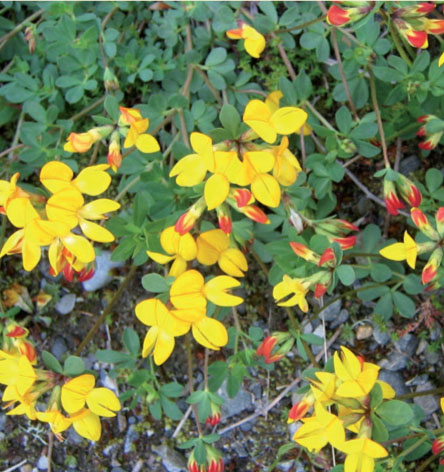
Nasturtium Tropaeolum majus – Large White (that’s its caterpillar), Small White.

Native grasses, such as Yorkshire Fog (left), Cocksfoot, False Brome, bents, fescues and meadow-grasses – skippers, Ringlet, Meadow Brown, Gatekeeper, Speckled Wood.

Butterfly houses
You may see wooden boxes on sale that are described as hibernation boxes for adult butterflies. They tend to have narrow vertical slits at the front and a hollow rear. But do they work?
Let’s say that there isn’t much evidence that they do! This perhaps isn’t surprising when you consider that there are only five species that regularly overwinter in an adult state in northern Europe: Brimstone, Comma, Peacock, Small Tortoiseshell and, recently, Red Admiral. Of these, the hibernation boxes perhaps best mimic the hollow tree hibernation sites naturally sought by the Peacock. So if you do use these boxes, just be aware that there are very few butterfly species they could possibly work for, and maybe spend your money on some nice butterfly nectar plants instead?
